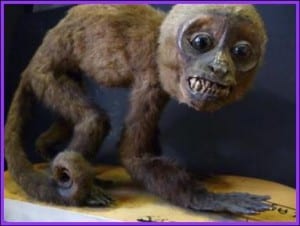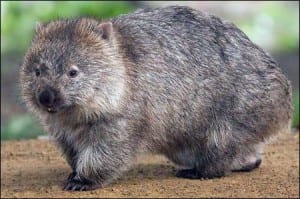Specimen of the Week: Week Seventy
By Emma-Louise Nicholls, on 11 February 2013
 The decision making for this week’s Specimen of the Week went along these lines:
The decision making for this week’s Specimen of the Week went along these lines:
Emma: ‘Can I do another shark?’
Manager: ‘No’
Emma: ‘How about a dogfish?’
Manager: ‘I’m not stupid’
Emma: ‘What do you mean?’
Manager: ‘Dogfish are a species of shark’
Emma: ‘Well what do you suggest then?’
Manager: ‘How about a marsupial?’
Emma: ‘Fine. But I’m writing this conversation as the introduction so I still get to mention sharks’
Manager: ‘I’ll edit it out’
Emma: ‘Not if I publish it first, mwah hah haaaaaaaah’
This week’s Specimen of the Week is…
**The Coarse-Haired Wombat** (A marsupial. Not a shark.)

The coarse-haired wombat at the Grant Museum of Zoology. LDUCZ-Z67
1) This species of wombat is usually referred to as the ‘common’ rather than the ‘coarse-haired’, but that’s not very nice for the lady wombats so we shall go with their other name. As with every species, of which there are three, the coarse-haired wombat is an Australian. It is found in south-eastern Australia and pops up sporadically all the way down from Queensland to the south-east of Australia, and hopping over the water to Tasmania and some other tiny little eruptions of water-locked land in the area.
2) The coarse-haired wombat is a nocturnal marsupial which means that the adult wombats live in the dark and the baby wombats live in the pouch. Unlike a lot of mammal species that have a breeding ‘season’, making it easy to divide the children into school groups, wombats just have a year round free for all. The baby wombat, or joey if you’d prefer, is born into the world about the size of a jelly bean. It then crawls through the mother’s fur until it reaches the pouch on the mum’s belly where it can access the milk and live a quiet life for the next five months as it develops into something a little more David Attenborough and a little less Nightmare on Elm Street. The joey depends on the female for around a year and a half and even after it first leaves the pouch, it will frequently creep back in for milk or to escape scary sights and sounds. Much like a bug hug from your mum. It will finally start to fend for itself after a quite reasonable seven months of age.

A coarse-haired wombat. Image taken by J. J. Harrison. (Image taken from commons.wikimedia.org)
3) The wombat has impressive teeth that never stop growing and so require a little maintenance to stop it resembling a vegetarian sabre-tooth cat. Fortunately this maintenance is easy and requires little more than eating a lot. The wombat’s diet comprises grasses, roots, and bark which are all tough enough to wear down the would be elephantine tusk length teeth. (Slight exaggeration.)
4) Not one to be a lazy layabout and steal the home of another, much like many of the animals we have visited over the past year, the coarse-haired wombat will dig its own burrow. Which must be a sweaty job given how big and fat they are/look. (Again, no offense intended to the lady coarse-haired wombats). It will find a suitable piece of land to own in an open grassland or eucalyptus forest and excavate an extensive blueprint of tunnels and chambers. Whilst other species of wombat are more gregarious party lovers who prefer to have house-mates, the coarse-haired wombat is a loner, opting for the quiet life and privacy of a secluded burrow to itself.
5) Unfortunately for the coarse-haired wombat, humans have introduced domestic dogs and then failed to look after them, resulting in a disease called sarcoptic mange, which a quick internet search will demonstrate, is a pretty high level of oh dear. Sadly, the wombat individuals that live on the fringes of their home-range, i.e. nearest to the hot zone of human presence, can be at high risk from catching this horrible disease. Whilst in Victoria, the coarse-haired wombat is classed as vermin, it is protected in other areas and is overall classed as Least Concern on the IUCN Red List of threatened species.

Snuggled up wombats. (Image taken by Emma-Louise Nicholls)
 Close
Close

